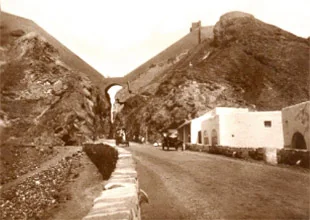In the shadow of Yemen’s craggy hills and moonlit paths lies a chilling legend that still stirs whispers among locals and travelers alike , the tale of The Aqaba Jinni.
Set in the port city of Aden, specifically along the rugged pass known as Al-Aqaba or Bab Aden, this enduring myth is more than just folklore. It is a tale woven into the streets and silence of a once-colonial stronghold, evoking an era when lanterns lit the roads and the unknown haunted the night.
Where the Legend Begins
Before 1850, the area now known as Aqaba was little more than a dusty passage linking Crater (the historical core of Aden) with the port town of Al-Mualla. This narrow road carved through the mountains became infamous as a haunted stretch where a beautiful, mysterious woman appeared under the cover of darkness.
By the 1960s, this legend had evolved into something far more sinister: a local terror. Eyewitness accounts described a woman of unearthly beauty walking alone on the Aqaba road late at night , except, according to terrified witnesses, she had the legs of a donkey.
Locals were so convinced of her presence that passengers in cars would often crane their necks out the window in hopes of catching a glimpse, only to be consumed by fear if they thought they saw her.
Some swore she waved at them. One man claimed to have picked her up in his vehicle, and according to him, she fell in love with him and asked him to follow her , not to a known place, but to her family’s home in the mythical City of the Jinn, located beneath the waters of Haqqat Bay.
A Ghostly Villa and a True Account
The legend of the Aqaba Jinni might have remained just another myth , until a peculiar real-life account from 1962 added fuel to the fire.
During British rule in Aden, a group of newly appointed Yemeni police officers were stationed in a lavish villa inside the Armed Police Camp. The villa, designed in the style of old Indian colonial houses, had stood empty for years despite its beauty. Its history was troubling.
An 18-year-old officer, part of the group, recalled a terrifying night. While on overnight duty, the villa’s cook, a cheerful man named Abdu, suddenly barged into his office clutching his bedding, trembling with fear. He claimed that the kitchen lights had turned on by themselves, and water was running with no one in sight. The officer initially dismissed it as superstition , until he saw the kitchen: dishes scattered, as if disturbed by an invisible force. Strict military discipline ensured the kitchen was always immaculate.
Each night he was on duty, the same thing happened: the kitchen left in disarray. Confused, the young officer eventually asked a senior trainer about the building. The trainer, Corporal Al-Abbar, hesitated , then confessed a dark secret.
Twelve years earlier, the villa was home to an Indian officer and his stunning young wife. One night, while cleaning his service pistol, a bullet was fired by mistake, killing his wife instantly. Stricken with grief, the officer resigned and left Aden. Every subsequent tenant, Arab or British, reported ghostly sightings , the figure of a woman walking silently through the villa’s upper floor. The hauntings grew so terrifying that the British commander of the camp, Lt. Colonel Shepherd, ordered the villa sealed off indefinitely.
Eventually, the villa was reopened only because it was thought that a group of young cadets living there together might keep the spirit at bay. The ghost, it seems, had not left.
Bab Aden: A Gate of Myths and Echoes
The Aqaba Pass, also known historically as Bab Aden - is more than just a road. It is a strategic entry carved into Mount Takar, forming a vital gateway between Crater and Al-Mualla. According to ancient Yemeni texts, the gate dates back to the mythical era of Shaddad ibn ‘Ad, who supposedly turned Aden into a prison city, sealed by this very mountain gate.
Expanded during the Rasulid dynasty in 809 AH (circa 1406 AD) and modified again by the British in 1867 with the addition of a bridge (later removed in 1963), the gate’s history is as layered as its legends. The pass, steeped in folklore, still evokes the mystery of ancient Arabia.
Spirits of Southern Yemen
The Aqaba Jinni is not alone. In southern Yemen, spirits and jinn (supernatural beings in Islamic folklore) are commonly referred to as "Tahoush." There are many places reputed to be haunted: the alleys of Zaghtut al-Kasah, the haunted Zaghtut Bajneid, the Abid Island, Sirah Fortress, and even coastal areas like Faqm and Ma’jilin. One especially infamous spot is Bawhat Well, said to house a rebellious jinn named Bahoot, who defied the legendary King Solomon and fled to Aden.
Interpreting the Legend: Folklore, Trauma, and the Unknown
To Western readers, the legend of the Aqaba Jinni may echo familiar themes: the banshee of Irish lore, the La Llorona of Mexican myth, or the Lady in White of haunted highways. Such figures often emerge where grief, guilt, and tragedy intersect, particularly in post-colonial settings where trauma lingers in the land.
But what makes the Aqaba Jinni unique is how the supernatural is tied not just to an emotional tale but also to real spaces: a villa, a road, a gate. This is not just a ghost story; it’s a cultural archive, a mirror of Aden’s fractured past, and perhaps, a metaphor for what lies hidden beneath any city once shaped by occupation, loss, and silence.
The legend of the Aqaba Jinni survives not because people fear her, but because, in some way, they remember her. Whether as a spirit with donkey legs luring travelers to a submerged world, or a restless ghost disturbed by a tragic accident, she is part of Yemen’s mythic geography.
And in the hills above Crater, when the moon is high and the lanterns flicker, some still wonder if she walks the pass.







No comments:
Post a Comment